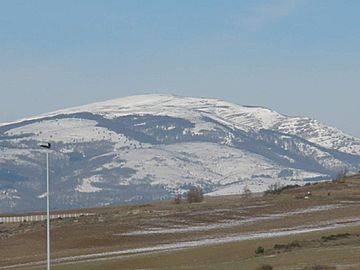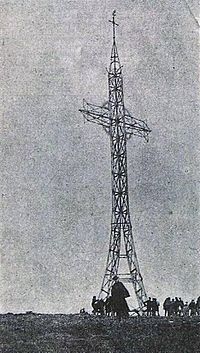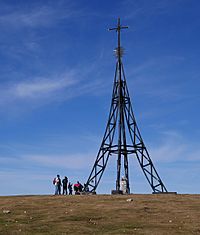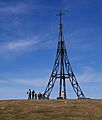Gorbea facts for kids
Quick facts for kids Gorbea |
|
|---|---|
| Gorbeia | |

Gorbea, seen from Vitoria-Gasteiz
|
|
| Highest point | |
| Elevation | 1,482 m (4,862 ft) |
| Prominence | 866 m (2,841 ft) |
| Naming | |
| Language of name | Lua error in Module:ISO_639_name at line 108: attempt to index local 'data' (a nil value). |
| Geography | |
| Location | Álava and Biscay, Basque Country, Spain |
| Parent range | Basque mountains |
| Climbing | |
| Easiest route | Hike |
Gorbea (also called Gorbeia) is a famous mountain and a group of mountains in the Basque Country, Spain. It's the tallest peak in the areas of Biscay and Álava. Gorbea stands tall at 1,482 meters (about 4,862 feet) above sea level.
The Gorbea mountain range covers a large area between these two regions. The main peak is a round, grassy mountain. On top, there's a big metal cross, 17 meters (about 56 feet) tall. Long ago, Gorbea was one of the five "horn mountains" of Biscay. From these mountains, people would blow horns to announce important meetings. These meetings were for the "Juntas Generales," which were like local government assemblies.
North of Gorbea, you'll find the karstic plateau of Itxina. This area has many deep holes and caves, like Supelegor cave. The southern part of the mountain is smoother and covered with thick forests. Other important mountains in this area include Berretin to the south. Also, Lekanda and Aldamin are limestone peaks to the north.
Since 1994, the entire Gorbea mountain range has been a Natural Park. This park helps protect the local beech and oak trees. It also protects animals like wild boars and deer. Because it's the highest mountain in two provinces and easy to reach, Gorbea is a very special mountain in the Basque Country.
Contents
The Gorbea Summit Cross
First Cross on Gorbea
In 1899, Pope Leo XIII asked for crosses to be built on important mountains. This was to celebrate the start of a new century. People decided to put a cross on Gorbea, since it was the highest mountain in Biscay and Álava.
Priests from nearby towns started planning the cross. Money for the project came from donations. The Diocese of Vitoria oversaw the building. The total cost was 50,000 Spanish pesetas, which was a lot of money back then.
The architect Casto de Zavala designed the cross. A businessman named Serapio de Goicoechea built it in his factory. Work began on July 26, 1901. They hoped to finish by September 14, but it wasn't ready until November 12.
Building the cross was very difficult. The parts were taken by train to Izarra. Then, working animals carried them up the mountain. The cross was supposed to be 33.33 meters (about 109 feet) tall. But for some reason, it wasn't built exactly as planned. The original design included strong wires to help it stand against strong winds. However, these wires were not added because they rushed the construction.
Just one month later, on December 12, the cross fell down. Heavy snow made one of its legs snap about 6 meters (20 feet) up. The cross then tumbled down the slope and broke into many pieces.
Second Cross on Gorbea
After the first cross fell, people quickly started planning to rebuild it. The new design was very similar to the first one. This second cross was officially opened on October 1, 1903. Many people attended the ceremony. The cross was even blessed with water from the Jordan River.
However, this second cross didn't last much longer than the first. Strong winds tore it down on February 12, 1906, just over two years after it was built.
Third and Current Cross
To avoid more disappointment, the third cross was built quietly. Because of this, we don't know many details about its construction. The cross was finished around 1910. Some say it might have started or finished in 1907.
This third cross is 17.23 meters (about 56.5 feet) tall. It's much shorter and stronger than the first two. The cross looks a bit like the Eiffel Tower. It stands on four strong legs that join together at the top. Two of the legs are in Biscay, and the other two are in Álava.
In June 1963, a statue of Our Lady of Begoña was placed under the cross. The cross has been repaired and updated a few times, including in 1991 and again in 2019. It stands proudly on Gorbea today.
Images for kids
See also
 In Spanish: Monte Gorbea para niños
In Spanish: Monte Gorbea para niños





